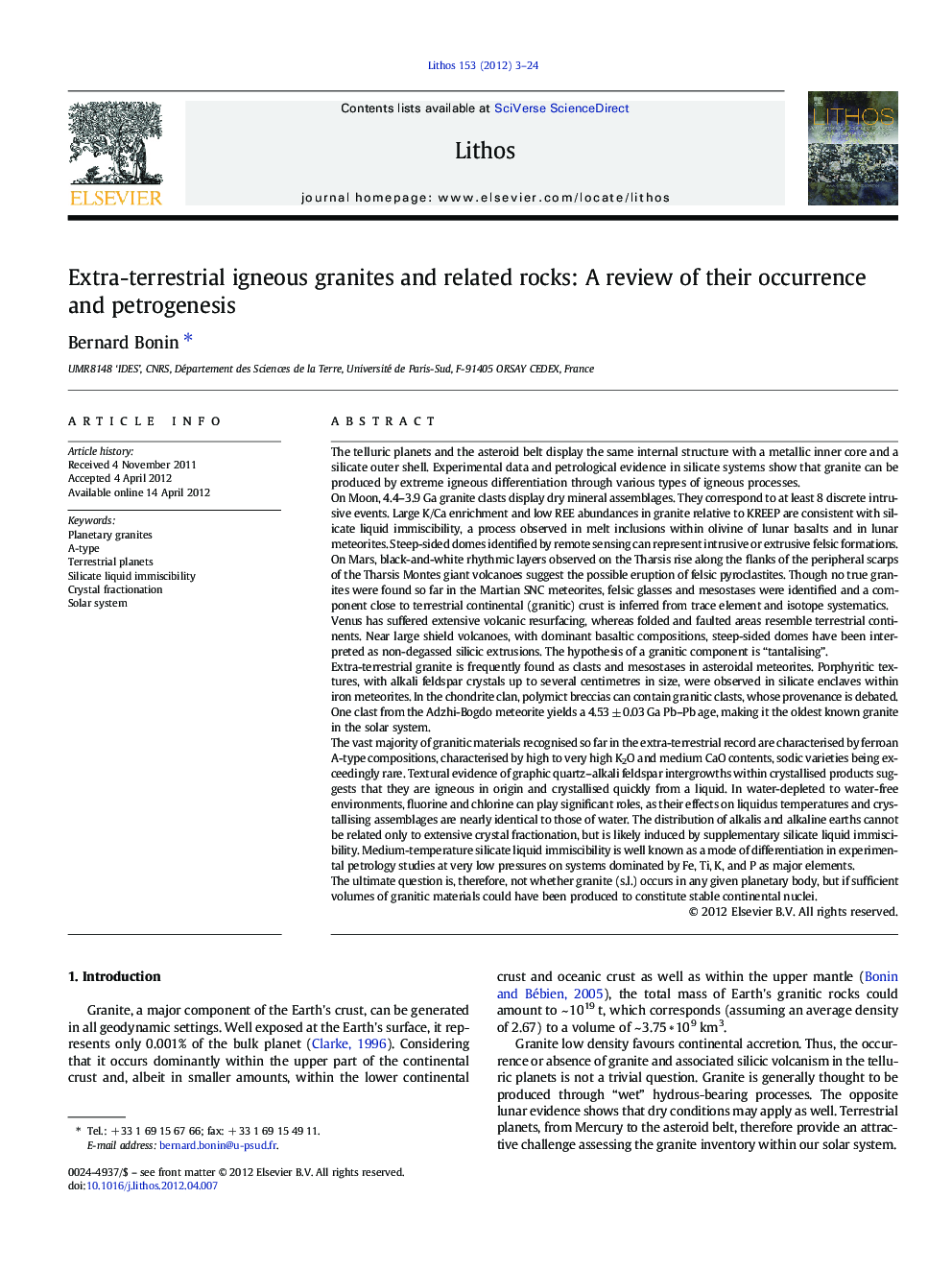| کد مقاله | کد نشریه | سال انتشار | مقاله انگلیسی | نسخه تمام متن |
|---|---|---|---|---|
| 4716425 | 1638700 | 2012 | 22 صفحه PDF | دانلود رایگان |

The telluric planets and the asteroid belt display the same internal structure with a metallic inner core and a silicate outer shell. Experimental data and petrological evidence in silicate systems show that granite can be produced by extreme igneous differentiation through various types of igneous processes.On Moon, 4.4–3.9 Ga granite clasts display dry mineral assemblages. They correspond to at least 8 discrete intrusive events. Large K/Ca enrichment and low REE abundances in granite relative to KREEP are consistent with silicate liquid immiscibility, a process observed in melt inclusions within olivine of lunar basalts and in lunar meteorites. Steep-sided domes identified by remote sensing can represent intrusive or extrusive felsic formations.On Mars, black-and-white rhythmic layers observed on the Tharsis rise along the flanks of the peripheral scarps of the Tharsis Montes giant volcanoes suggest the possible eruption of felsic pyroclastites. Though no true granites were found so far in the Martian SNC meteorites, felsic glasses and mesostases were identified and a component close to terrestrial continental (granitic) crust is inferred from trace element and isotope systematics.Venus has suffered extensive volcanic resurfacing, whereas folded and faulted areas resemble terrestrial continents. Near large shield volcanoes, with dominant basaltic compositions, steep-sided domes have been interpreted as non-degassed silicic extrusions. The hypothesis of a granitic component is “tantalising”.Extra-terrestrial granite is frequently found as clasts and mesostases in asteroidal meteorites. Porphyritic textures, with alkali feldspar crystals up to several centimetres in size, were observed in silicate enclaves within iron meteorites. In the chondrite clan, polymict breccias can contain granitic clasts, whose provenance is debated. One clast from the Adzhi-Bogdo meteorite yields a 4.53 ± 0.03 Ga Pb–Pb age, making it the oldest known granite in the solar system.The vast majority of granitic materials recognised so far in the extra-terrestrial record are characterised by ferroan A-type compositions, characterised by high to very high K2O and medium CaO contents, sodic varieties being exceedingly rare. Textural evidence of graphic quartz–alkali feldspar intergrowths within crystallised products suggests that they are igneous in origin and crystallised quickly from a liquid. In water-depleted to water-free environments, fluorine and chlorine can play significant roles, as their effects on liquidus temperatures and crystallising assemblages are nearly identical to those of water. The distribution of alkalis and alkaline earths cannot be related only to extensive crystal fractionation, but is likely induced by supplementary silicate liquid immiscibility. Medium-temperature silicate liquid immiscibility is well known as a mode of differentiation in experimental petrology studies at very low pressures on systems dominated by Fe, Ti, K, and P as major elements.The ultimate question is, therefore, not whether granite (s.l.) occurs in any given planetary body, but if sufficient volumes of granitic materials could have been produced to constitute stable continental nuclei.
► Granite is widespread in meteorites and terrestrial planets.
► The oldest granite is only 30 My younger than the formation of the solar system.
► Silicic compositions share A-type affinities.
► They are produced by fractionation and silicate liquid immiscibility.
► Continental nuclei likely occur outside the Earth.
Journal: Lithos - Volume 153, 15 November 2012, Pages 3–24